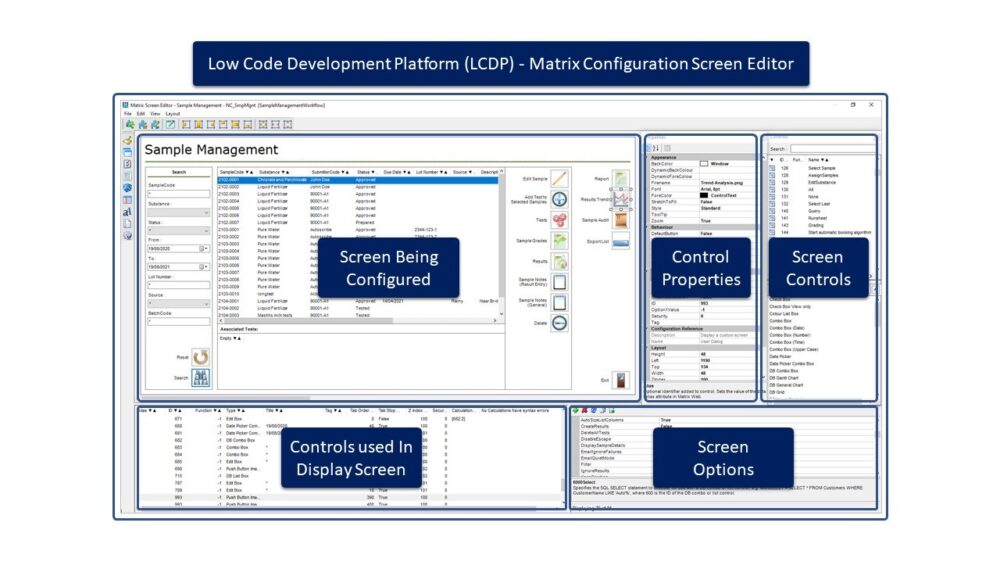Blog: Applications
Low Code Development Platform Approaches to LIMS Configuration
22nd May 2024

In previous blogs we have looked at the differences between Configuration and Customization. In this blog we discuss Autoscribe Informatics’ approach to configuration using a Low-Code Development Platform (LCDP), and why LCDP provides advantages over traditional approaches to LIMS configuration.
What is LIMS Configuration?
We should first define what LIMS configuration is, and what it is not. LIMS configuration is the ability to change the behavior of the workflow and functionality of the system to meet your unique needs.
LIMS configuration does not mean defining and managing master or static data. We define master or static data to include test definitions, test limits, instrument details, submitter information, and similar data within the LIMS. It can be seen as the data that defines the structure of the system as well as the laboratory and organizational environment. As such, after initial system definition, it is not subject to frequent addition or modification. The ability to setup and manage master data is a standard part of Matrix Gemini LIMS, as it should be for any LIMS.
Pioneers in Low-Code Development Platforms (LCDPs) for LIMS Configuration
Autoscribe’s approach to configuration is very different to other LIMS vendors. Autoscribe were pioneers in configurable LIMS, introducing its LIMS Configuration Tools in 1996. Configuration Tools can best be described today as a Low-Code Development Platform (LCDP). It allows non-programmers to create applications through a graphical user interface instead of traditional computer programming.
Low-Code Development Platforms (LCDPs) are designed to expedite the application development process. They eliminate the need for specialist software coding skills, which are usually held within corporate IT teams and are often in short supply. Instead, graphical tools are used to manipulate standard controls that create the required screens and workflow.
LIMS configuration is achieved with no impact on the underlying software. Indeed, by design, the system configuration is kept separate from the underlying software. This in turn allows software updates to be applied with no impact on the configuration, simplifying both maintenance and upgrade of the LIMS.
Even though the term LCDP was not coined by Forrester Research until 2014, every LIMS delivered since 1996 (18 years before this) has been able to take advantage of these Configuration Tools. This makes it a well proven LIMS technology that has been adopted by users of our LIMS. These users have been able to keep their LIMS up to date with changing technology while maintaining or improving their specific LIMS workflows.
The benefits of LIMS Configuration through LCDP include the following:
- Configuration can be performed by Autoscribe or by trained and authorized users within a customer organization (no programming skills needed).
- Configuration by the customer will be supported by Autoscribe within the annual support agreement at no extra cost.
- Agile reuse – the functional, workflow and interface controls required to configure the system are already defined and available.
- Elimination of bespoke code that can interfere with system upgrades and support.
Why is this important in the LIMS world?
Every laboratory’s needs are different. It is well-known that almost every scientific laboratory has a different set of user requirements for LIMS, with the overlap in requirements being as low as 50%. Most LIMS vendors have coded solutions that are modified by adding to, or modifying, existing software code (C#, C++, Basic, Java, Python, HTML and similar).
Autoscribe took the approach of creating a standard set of core code to provide the functionality that addresses the requirements that overlap from customer to customer e.g., sample registration, result entry etc. These controls (blocks of software code) are tested and released within the LCDP. This allows users to pick and configure them to form the workflow screens needed for that laboratory implementation.
Configuration - A Two Step Approach
Even though the needs of every laboratory are different, they can still be grouped together, often by Industry type. Creating typical configurations for these industries saves implementation time and allows a project to ‘go-live’ faster. Autoscribe calls these typical configurations ‘Starter Configurations’. The General Laboratory configuration is ideal for general QC testing, and Contract Laboratories with the addition of commercial functions such as price management, creation of quotations etc. The Regulated Manufacturing configuration tests products throughout the manufacturing cycle and provides recipe and batch management functions to trace raw materials to final product, a key part of pharmaceutical, food and beverage, and general manufacturing operations. Other industry specific starter systems include Veterinary, Biobanking, Water/Environmental and Covid Testing.
Further customer specific configuration of these already pre-configured starter systems allows laboratories to be up and running with a system close to their needs very quickly.
The unique Autoscribe approach allows:
- Fast initial implementation of starter systems.
- Very close, if not exact, fit to specific customer requirements.
- Simpler system validation and re-validation. Re-validation can be confined to specific screens and workflows, for example.
- Future proofing as configuration changes can be made as business requirements change, all without impact on the standard core code or system support.
Benefits of LIMS Configuration Using LCDP
Richness of LIMS functionality is not compromised using LCDP. The key is to define the controls in such a way that they can be used flexibly in the graphical configuration platform without compromise. Autoscribe has developed applications for mortuary management, stability study management, and clinical systems, for example, without the need to write one line of underlying code. These systems, with identical core code to the LIMS, are in operation with Autoscribe customers today. This means that Autoscribe has one set of LIMS core code to support and upgrade, and customers benefit from this as well.
Large companies often find an ideal LIMS for one part of their organization, often the lead laboratory, and then have difficulty adapting it to suit other teams in other areas of their business. The highly adaptable nature of Matrix Gemini LIMS ensures that each site/department can have a user interface and associated functionality to suit their specific needs without affecting other sites/departments in the organization. This is done using the LCDP approach and therefore avoiding potential problems with future updates and support.
Using the LDCP approach means that all workflows and screens can be configured to meet the users’ needs. An interface adapted to their working practices ensures users understand and adopt the LIMS quickly. Continued acceptance can be ensured by adapting the LIMS to changing working practices over time. Several of Autoscribe Informatics’ earliest customers are still using our LIMS today, regularly updating their system to take advantage of new and improved functionality and technology.
Since identical core code blocks are reused repeatedly the LCDP approach can provide excellent productivity savings when configuring the system. It allows higher-level ‘laboratory centric’ configuration without the need to develop additional core code, bringing configuration closer to the end user.
LCDP delivers clear cost and time savings for both a LIMS manager and the laboratory or laboratories using the LIMS. Flexibility, upgradeability, ease of use, and maintainability make a sound business case for the use of a LCDP for LIMS Configuration.
LIMS Implementation Service
Learn more about how we can help you get your perfect LIMS using our LIMS implementation services.
